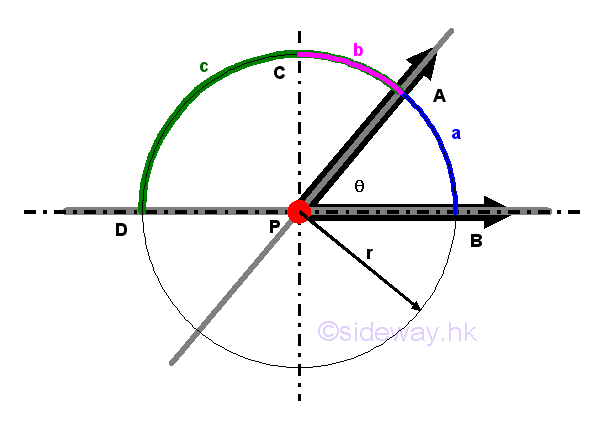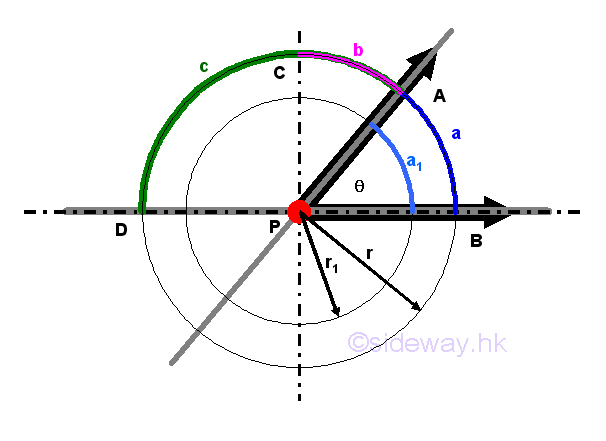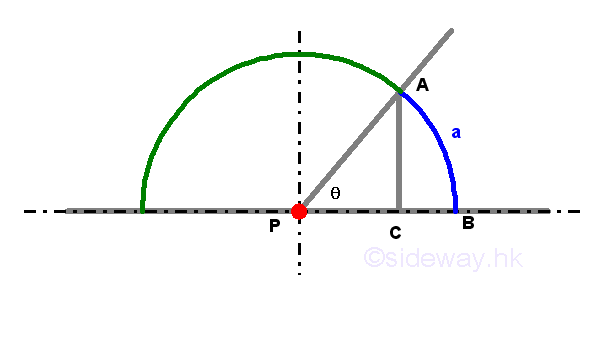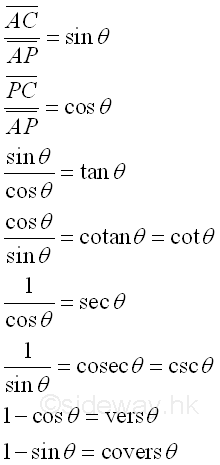Content
Trigonometry
Angle
Functions of an Angle
Relations of Functions of an Angle
Trigonometry
Trigonometry is originally the study of the correlation between the sides and angles of a triangle. Trigonometry is also called plane trigonometry because the triangle is described on a plane. When the triangle is described on a spherical surface, it is called spherical trigonometry.
Angle
An angle is defined as the inclination of one straight line to another straight line about a point in geometry but a more boarder meaning is used in trigonometry where angle is the revolution of a ray refered to a fixed ray with a common vertex and the angular motion can be either counter clockwise or clockwise. Angle measurement in trigonometry is therefore can be greater than π or 2π in general.

Let θ be the angle of APB in radian and a be the subtending arc by angle θ at radius r. Let π be the straight angle. Then angle (π/2-θ) is called the complement of θ and angle (π-θ) is called the supplement of θ. Similarly arc b is called the complement of a and arc c is called the supplement of a.

From geometry, the ratio of the circumference of any circle over its radius is equal to a constant quantity 2π. Since angle at C is proportional to the subtending arc. Therefore an angle can be expressed in term of the arc subtended by proportional, rθ/2πr=θ/2π. When the arc length is equal to the radius, by proportional, r/2πr=1/2π, the quantity from radius is called one radian. A right angle is equal to π/2 and a straight angle is equal to π.
Another way to measure an angle is by dividing the circumference of a complete circle into 360 equal portions. The angle subtended by one portion of the divided arc is equal to one degree. Each degree can be divided into 60 equal parts call minutes. Each minute can further be divided into 60 equal parts call seconds. A right angle is therefore equal to 90 degrees and a straight angle is equal to 180 degrees. The division of circumference of a circle into 360 degrees is called the sexagesimal divison which is difference from those division by dividing a circle into 100 degress called centesimal.
Since both radian and degree are dervied from the circumference of a circle, both measurements can be converted to each other through a simple relationship, i.e. degree/360=radian/2π.
The division of the circumference of a circle into 360 degrees with 1 degree equals to 60 minutes and 1 minute equals to 60 seconds is called sexagesimal division. And there is also an impopular centesimal division, for which the circumference of a circle into 100 degrees with 1 degree equals to 100 minutes and 1 minute equals to 100 seconds
Functions of an Angle

Let P be the centre of a circle of any radius, PB be a horizontal line and θ be the angle subtended by an arc BA with sides PB and PA. A line AC is drawed perpendicular to PB. The ratio of AC over PA is called the sine of the angle θ and the ratio of PC over PA is called the cosine of the angle θ. The ratio of sine of the angle θ to the cosine of the angle θ is called the tangent of angle θ, while the inverse of the ratio is called the cotangent. The ratio of unity to the cosine of angle θ is called the secant of angle θ, and the ratio of unity to the sine of angle θ is called cosecant of angle θ. The difference between unity and the cosine of angle θ is called the versed-sine of angle θ, the difference between unity and the sine of angle θ is called the coversed-sine of angle θ. Imply functions of angle are

Relations of Functions of an Angle
From the right triangle △ACP, by Pythagorean theorem
©sideway
ID: 130700004 Last Updated: 7/2/2013 Revision: 0 Ref:
References
- B. Joseph, 1978, University Mathematics: A Textbook for Students of Science & Engineering
- Ayres, F. JR, Moyer, R.E., 1999, Schaum's Outlines: Trigonometry
- Hopkings, W., 1833, Elements of Trigonometry
Latest Updated Links
- Panasonic SR-CK05 RiceCooker CW-HZ70AA(last updated On 11/17/2025)
- Panasonic Hood Structure Ventilating Fan Blade Diameter: 8in FV-20WH307 CW-HZ70AA(last updated On 11/16/2025)
- Panasonic Window Mount Thermo Ventilator FV-30BW2H CW-HZ70AA(last updated On 11/15/2025)
- Panasonic Inverter PRO Inverter Window Heatpump Air-Conditioner (3/4 HP) CW-HZ70AA(last updated On 11/14/2025)
- Panasonic Inverter Window-Split Type Cooling Only Air-Conditioner (1 HP) CS-U9YWA(last updated On 11/13/2025)
- Panasonic Inverter Steam and Grill_Microwave Oven 27L NN_DS59NB(last updated On 11/12/2025)
- Panasonic KY-C223B Induction Cooker(last updated On 11/11/2025)
- Focus M41 Single lever kitchen mixer 160(last updated On 11/10/2025)
- Focus Single lever basin mixer 230(last updated On 11/9/2025)
- Precision Start Thermostat shower mixer(last updated On 11/8/2025)
- Tempesta 100 Shower Rail Set 3 sprays(last updated On 11/7/2025)

 Nu Html Checker
Nu Html Checker  53
53  na
na  na
na
Home 5
Business
Management
HBR 3
Information
Recreation
Hobbies 8
Culture
Chinese 1097
English 339
Travel 18
Reference 79
Hardware 40
Computer
Hardware 259
Software
Application 213
Digitization 37
Latex 52
Manim 205
KB 1
Numeric 19
Programming
Web 289
Unicode 504
HTML 66
CSS 65
SVG 46
ASP.NET 270
OS 431
DeskTop 7
Python 72
Knowledge
Mathematics
Formulas 8
Set 1
Logic 1
Algebra 84
Number Theory 206
Trigonometry 31
Geometry 34
Calculus 67
Engineering
Tables 8
Mechanical
Rigid Bodies
Statics 92
Dynamics 37
Fluid 5
Control
Acoustics 19
Natural Sciences
Matter 1
Electric 27
Biology 1
